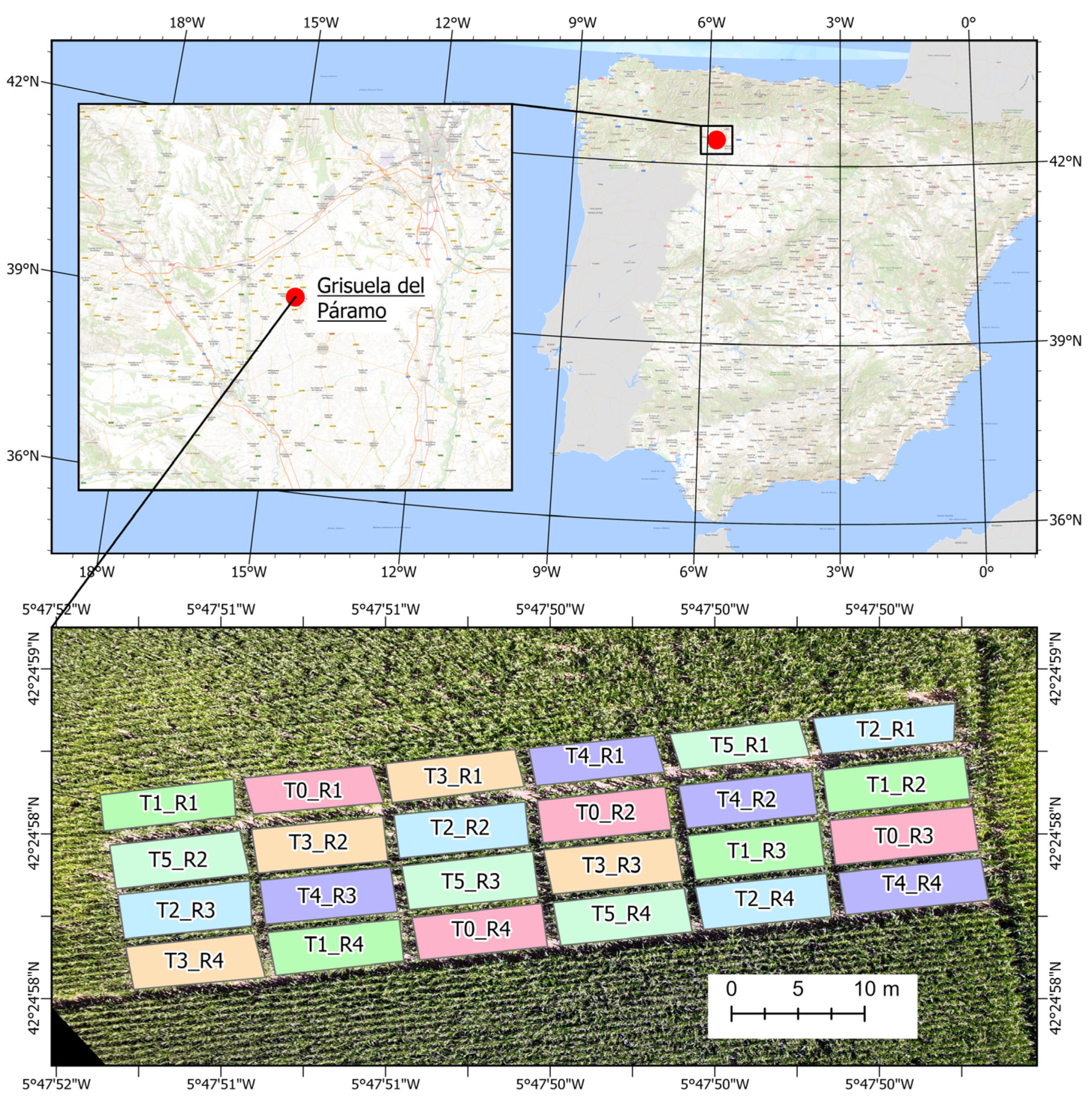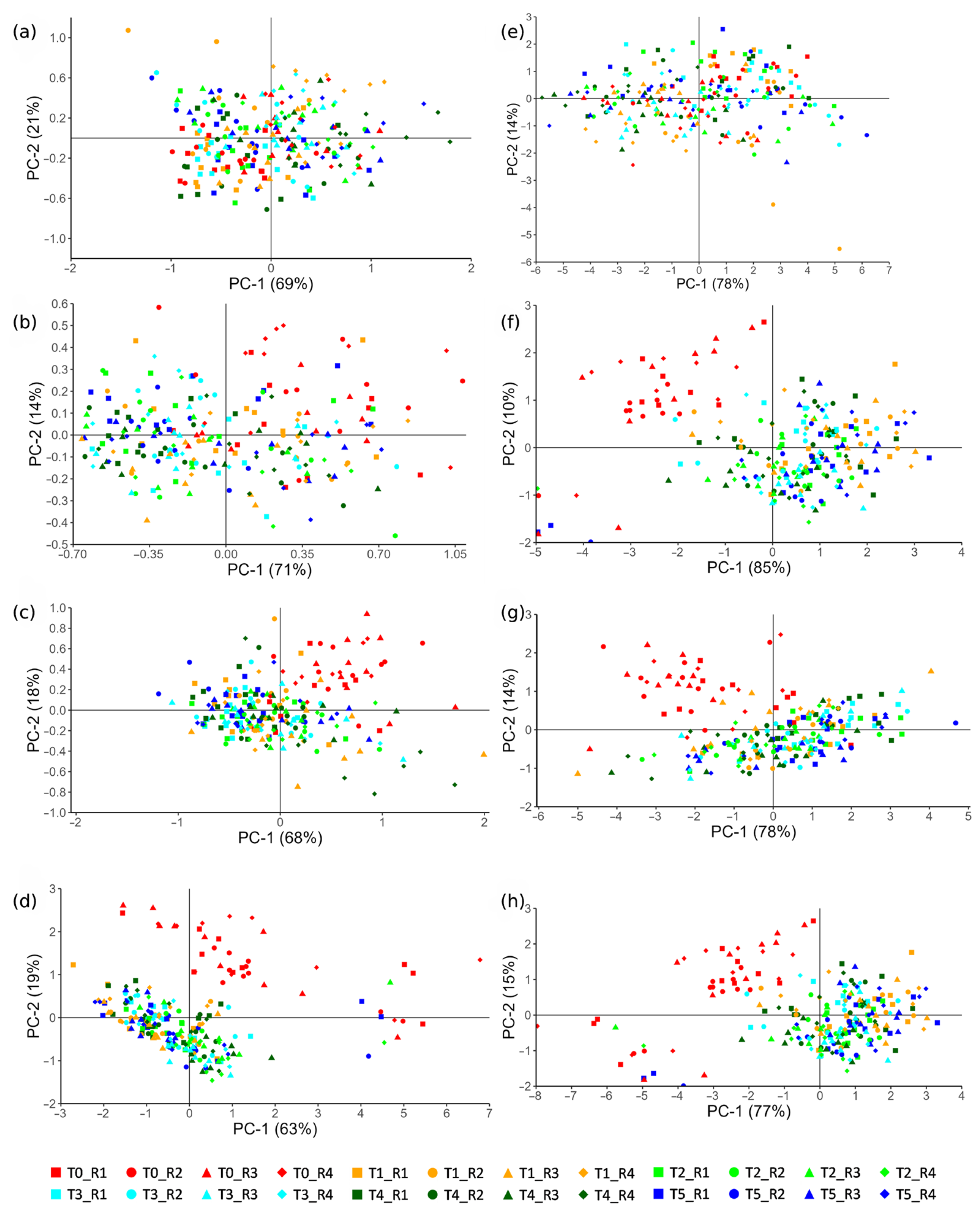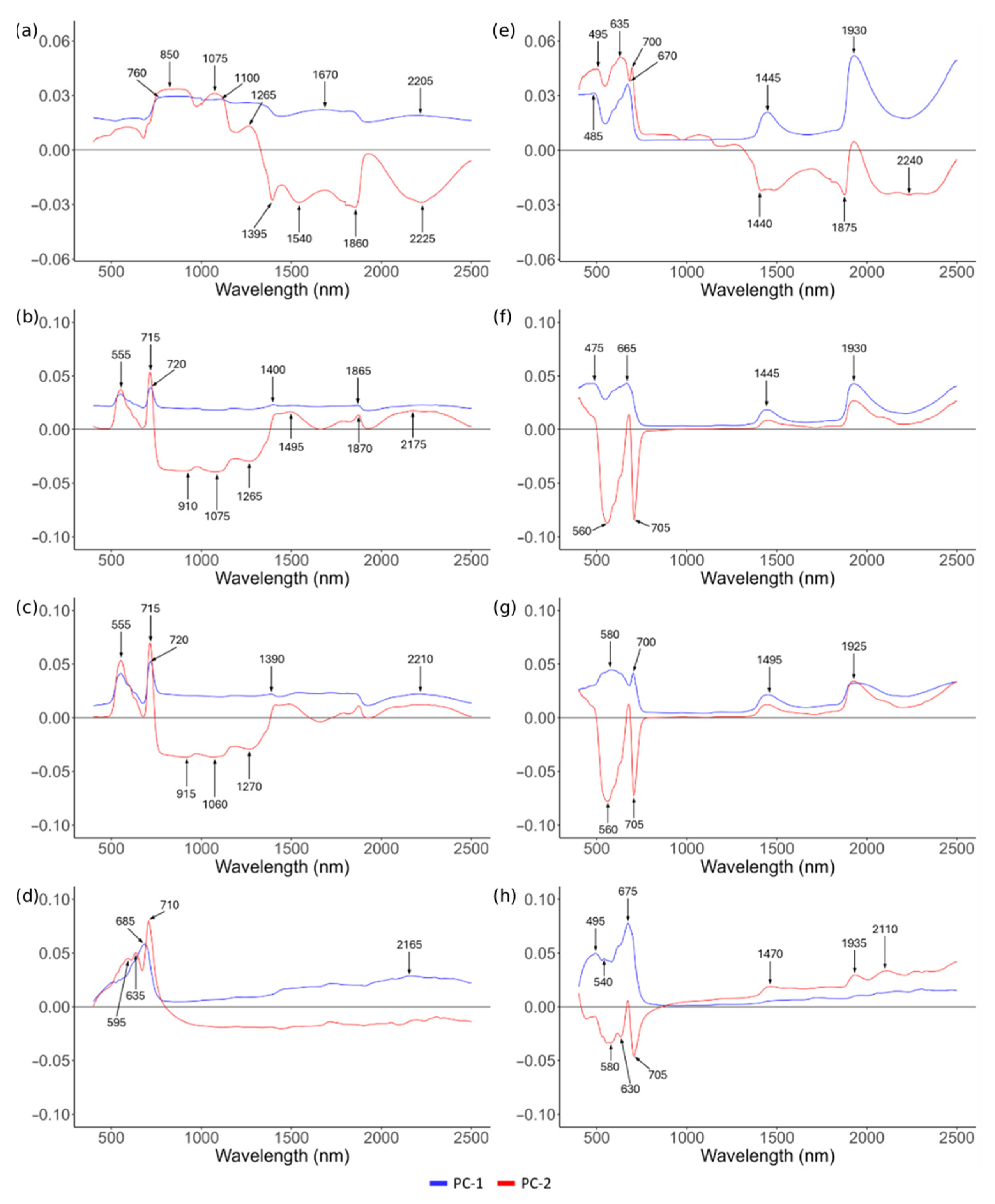Field Spectroscopy for Monitoring Nitrogen Fertilization and Estimating Cornstalk Nitrate Content in Maize
Abstract
1. Introduction
2. Materials and Methods
2.1. Study Site and Experiment Design
2.2. Data Collection
2.3. Spectral Analysis
3. Results
3.1. Spectral Signatures
3.2. Effects of Nitrogen Treatments on Corn Yield Variables
3.3. Estimation of Cornstalk Nitrate Content Using Spectroscopy
4. Discussion
4.1. Effect of Nitrogen Fertilization on the Spectral Signature
4.2. Performance of Models Regarding Estimation of Cornstalk Nitrate Content Based on Field Spectroscopy
5. Conclusions
Author Contributions
Funding
Data Availability Statement
Acknowledgments
Conflicts of Interest
References
- Erenstein, O.; Jaleta, M.; Sonder, K.; Mottaleb, K.; Prasanna, B.M. Global Maize Production, Consumption and Trade: Trends and R&D Implications. Food Secur. 2022, 14, 1295–1319. [Google Scholar] [CrossRef]
- da Oliveira, A.K.S.; Rizzo, R.; Silva, C.A.A.C.; Ré, N.C.; Caron, M.L.; Fiorio, P.R. Prediction of Corn Leaf Nitrogen Content in a Tropical Region Using Vis-NIR-SWIR Spectroscopy. AgriEngineering 2024, 6, 4135. [Google Scholar] [CrossRef]
- Yang, K.; Li, Y. Effects of Water Stress and Fertilizer Stress on Maize Growth and Spectral Identification of Different Stresses. Spectrochim. Acta A Mol. Biomol. Spectrosc. 2023, 297, 122703. [Google Scholar] [CrossRef] [PubMed]
- Yu, X.; Keitel, C.; Zhang, Y.; Wangeci, A.N.; Dijkstra, F.A. Global Meta-Analysis of Nitrogen Fertilizer Use Efficiency in Rice, Wheat and Maize. Agric. Ecosyst. Environ. 2022, 338, 108089. [Google Scholar] [CrossRef]
- Lu, J.; Hu, T.; Zhang, B.; Wang, L.; Yang, S.; Fan, J.; Yan, S.; Zhang, F. Nitrogen Fertilizer Management Effects on Soil Nitrate Leaching, Grain Yield and Economic Benefit of Summer Maize in Northwest China. Agric. Water Manag. 2021, 247, 106739. [Google Scholar] [CrossRef]
- Toselli, M.; Baldi, E.; Ferro, F.; Rossi, S.; Cillis, D. Smart Farming Tool for Monitoring Nutrients in Soil and Plants for Precise Fertilization. Horticulturae 2023, 9, 1011. [Google Scholar] [CrossRef]
- Bhatt, R.; Moulick, D.; Bárek, V.; Brestic, M.; Gaber, A.; Skalicky, M.; Hossain, A. Sustainable Strategies to Limit Nitrogen Loss in Agriculture through Improving Its Use Efficiency—Aiming to Reduce Environmental Pollution. J. Agric. Food Res. 2025, 22, 101957. [Google Scholar] [CrossRef]
- Pawase, P.P.; Nalawade, S.M.; Bhanage, G.B.; Walunj, A.A.; Kadam, P.B.; Durgude, A.G.; Patil, M.G. Variable Rate Fertilizer Application Technology for Nutrient Management: A Review. Int. J. Agric. Biol. Eng. 2023, 16, 11–19. [Google Scholar] [CrossRef]
- Morris, T.F.; Murrell, T.S.; Beegle, D.B.; Camberato, J.J.; Ferguson, R.B.; Grove, J.; Ketterings, Q.; Kyveryga, P.M.; Laboski, C.A.M.; McGrath, J.M.; et al. Strengths and Limitations of Nitrogen Rate Recommendations for Corn and Opportunities for Improvement. Agron. J. 2018, 110, 1–37. [Google Scholar] [CrossRef]
- Patel, A.K.; Ghosh, J.K.; Sayyad, S.U. Fractional Abundances Study of Macronutrients in Soil Using Hyperspectral Remote Sensing. Geocarto Int. 2022, 37, 474–493. [Google Scholar] [CrossRef]
- Yao, X.; Zhu, Y.; Tian, Y.C.; Feng, W.; Cao, W.X. Exploring Hyperspectral Bands and Estimation Indices for Leaf Nitrogen Accumulation in Wheat. Int. J. Appl. Earth Obs. Geoinf. 2010, 12, 89–100. [Google Scholar] [CrossRef]
- Fiorio, P.R.; Silva, C.A.A.C.; Rizzo, R.; Demattê, J.A.M.; dos Luciano, A.C.S.; da Silva, M.A. Prediction of Leaf Nitrogen in Sugarcane (Saccharum Spp.) by Vis-NIR-SWIR Spectroradiometry. Heliyon 2024, 10, e26819. [Google Scholar] [CrossRef] [PubMed]
- Weyer, L.G.; Lo, S.-C. Spectra–Structure Correlations in the Near-Infrared. In Handbook of Vibrational Spectroscopy; Chalmers, J.M., Griffiths, P.R., Eds.; John Wiley & Sons, Ltd.: Chichester, UK, 2006; pp. 1817–1837. [Google Scholar]
- Rambo, L.; Ma, B.L.; Xiong, Y.; da Silvia, P.R.F. Leaf and Canopy Optical Characteristics as Crop-N-Status Indicators for Field Nitrogen Management in Corn. J. Plant Nutr. Soil. Sci. 2010, 173, 434–443. [Google Scholar] [CrossRef]
- Tian, F.; Zhou, J.; Ransom, C.J.; Aloysius, N.; Sudduth, K.A. Estimating Corn Leaf Chlorophyll Content Using Airborne Multispectral Imagery and Machine Learning. Smart Agric. Technol. 2025, 10, 100719. [Google Scholar] [CrossRef]
- Berger, K.; Verrelst, J.; Féret, J.B.; Wang, Z.; Wocher, M.; Strathmann, M.; Danner, M.; Mauser, W.; Hank, T. Crop Nitrogen Monitoring: Recent Progress and Principal Developments in the Context of Imaging Spectroscopy Missions. Remote Sens. Environ. 2020, 242, 111758. [Google Scholar] [CrossRef]
- Graeff, S.; Claupein, W. Quantifying Nitrogen Status of Corn (Zea mays L.) in the Field by Reflectance Measurements. Eur. J. Agron. 2003, 19, 611–618. [Google Scholar] [CrossRef]
- Gautam, R.; Panigrahi, S. Leaf Nitrogen Determination of Corn Plant Using Aerial Images and Artificial Neural Networks. Can. Biosyst. Eng. 2007, 49, 7.1–7.9. [Google Scholar]
- Xie, C.; Yang, C.; Hummel, A., Jr.; Johnson, G.A.; Izuno, F.T. Spectral Reflectance Response to Nitrogen Fertilization in Field Grown Corn. Int. J. Agric. Biol. Eng. 2018, 11, 118–126. [Google Scholar] [CrossRef]
- Lu, Y.; Zhang, X.; Cui, Y.; Chao, Y.; Song, G.; Nie, C.; Wang, L. Response of Different Varieties of Maize to Nitrogen Stress and Diagnosis of Leaf Nitrogen Using Hyperspectral Data. Sci. Rep. 2023, 13, 5890. [Google Scholar] [CrossRef]
- Silva, F.H.C.A.; Wijewardane, N.K.; Bheemanahalli, R.; Raja Reddy, K.; Zhang, X.; Vennam, R.R. Comparison of UV, Visible and near-Infrared, and Mid-Infrared Spectrometers to Estimate Maize and Sorghum Leaf Nutrients Using Dry-Intact and Ground Leaves. Comput. Electron. Agric. 2023, 211, 108001. [Google Scholar] [CrossRef]
- Ramos-García, C.A.; Martínez-Martínez, L.J.; Bernal-Riobo, J.H. Estimación de Los Contenidos de Clorofila y Nitrógeno En Hojas de Maíz (Zea mays L.) Mediante Análisis Espectroscópico. Rev. Colomb. Cienc. Hortíc. 2022, 16, e13398. [Google Scholar] [CrossRef]
- Martin, M.E.; Plourde, L.C.; Ollinger, S.V.; Smith, M.L.; McNeil, B.E. A Generalizable Method for Remote Sensing of Canopy Nitrogen across a Wide Range of Forest Ecosystems. Remote Sens. Environ. 2008, 112, 3511–3519. [Google Scholar] [CrossRef]
- Viscarra Rossel, R.A.; Cattle, S.R.; Ortega, A.; Fouad, Y. In Situ Measurements of Soil Colour, Mineral Composition and Clay Content by Vis–NIR Spectroscopy. Geoderma 2009, 150, 253–266. [Google Scholar] [CrossRef]
- Rodrigues, M.; Nanni, M.R.; Cezar, E.; dos Santos, G.L.A.A.; Reis, A.S.; de Oliveira, K.M.; de Oliveira, R.B. Vis-NIR Spectroscopy: From Leaf Dry Mass Production Estimate to the Prediction of Macro- and Micronutrients in Soybean Crops. J. Appl. Remote Sens. 2020, 14, 044505. [Google Scholar] [CrossRef]
- Ge, Y.; Atefi, A.; Zhang, H.; Miao, C.; Ramamurthy, R.K.; Sigmon, B.; Yang, J.; Schnable, J.C. High-Throughput Analysis of Leaf Physiological and Chemical Traits with VIS-NIR-SWIR Spectroscopy: A Case Study with a Maize Diversity Panel. Plant Methods 2019, 15, 66. [Google Scholar] [CrossRef] [PubMed]
- Ritchie, S.W.; Hanway, J.J.; Benson, G.O. How a Corn Plant Develops; Iowa State University: Ames, IA, USA, 1986; Volume 48. [Google Scholar]
- Lau, I.C.; Cudahy, T.; Heinson, G.S.; Mauger, A.J.; James, P.R. Practical Applications of Hyperspectral Remote Sensing in Regolith Research. In Proceedings of the Advances in Regolith, Adelaide, Australia, 13–14 November 2003; Roach, I.C., Ed.; CRC LEME: Glen Osmond, SA, Australia, 2003; pp. 249–253. [Google Scholar]
- ASD Inc. FieldSpec® 3 User Manual; ASD: Boulder, CO, USA, 2010. [Google Scholar]
- Binford, G.D.; Blackmer, A.M.; Meese, B.G. Optimal Concentrations of Nitrate in Cornstalks at Maturity. Agron. J. 1992, 84, 881–887. [Google Scholar] [CrossRef]
- Binford, G.D.; Blackmer, A.M.; El-Hout, N.M. Tissue Test for Excess Nitrogen during Corn Production. Agron. J. 1990, 82, 124–129. [Google Scholar] [CrossRef]
- Mann, H.B.; Whitney, D.R. On a Test of Whether One of Two Random Variables Is Stochastically Larger than the Other. Ann. Math. Statist. 1947, 18, 50–60. [Google Scholar] [CrossRef]
- Min, M.; Lee, W.S.; Kim, Y.H.; Bucklin, R.A. Nondestructive Detection of Nitrogen in Chinese Cabbage Leaves Using VIS–NIR Spectroscopy. HortScience 2006, 41, 162–166. [Google Scholar] [CrossRef]
- Rawal, A.; Hartemink, A.; Zhang, Y.; Wang, Y.; Lankau, R.A.; Ruark, M.D. Visible and Near-Infrared Spectroscopy Predicted Leaf Nitrogen Contents of Potato Varieties under Different Growth and Management Conditions. Precis. Agric. 2024, 25, 751–770. [Google Scholar] [CrossRef]
- Gamon, J.A.; Somers, B.; Malenovský, Z.; Middleton, E.M.; Rascher, U.; Schaepman, M.E. Assessing Vegetation Function with Imaging Spectroscopy. Surv. Geophys. 2019, 40, 489–513. [Google Scholar] [CrossRef]
- Davies, B.; Coulter, J.A.; Pagliari, P.H. Timing and Rate of Nitrogen Fertilization Influence Maize Yield and Nitrogen Use Efficiency. PLoS ONE 2020, 15, e0233674. [Google Scholar] [CrossRef] [PubMed]
- Lee, H.; Wang, J.; Leblon, B. Using Linear Regression, Random Forests, and Support Vector Machine with Unmanned Aerial Vehicle Multispectral Images to Predict Canopy Nitrogen Weight in Corn. Remote Sens. 2020, 12, 2071. [Google Scholar] [CrossRef]
- Thenkabail, P.S.; Mariotto, I.; Gumma, M.K.; Middleton, E.M.; Landis, D.R.; Huemmrich, K.F. Selection of Hyperspectral Narrowbands (Hnbs) and Composition of Hyperspectral Twoband Vegetation Indices (HVIS) for Biophysical Characterization and Discrimination of Crop Types Using Field Reflectance and Hyperion/EO-1 Data. IEEE J. Sel. Top. Appl. Earth Obs. Remote Sens. 2013, 6, 427–439. [Google Scholar] [CrossRef]
- Hank, T.B.; Berger, K.; Bach, H.; Clevers, J.G.P.W.; Gitelson, A.; Zarco-Tejada, P.; Mauser, W. Spaceborne Imaging Spectroscopy for Sustainable Agriculture: Contributions and Challenges. Surv. Geophys. 2019, 40, 515–551. [Google Scholar] [CrossRef]
- Blackmer, T.M.; Schepers, J.S.; Varvel, G.E.; Walter-Shea, E.A. Nitrogen Deficiency Detection Using Reflected Shortwave Radiation from Irrigated Corn Canopies. Agron. J. 1996, 88, 1–5. [Google Scholar] [CrossRef]
- Dong, R.; Miao, Y.; Wang, X.; Chen, Z.; Yuan, F.; Zhang, W.; Li, H. Estimating Plant Nitrogen Concentration of Maize Using a Leaf Fluorescence Sensor across Growth Stages. Remote Sens. 2020, 12, 1139. [Google Scholar] [CrossRef]
- Jaberi-Aghdam, M.; Momayezi, M.R.; Bagheri, N.; Azizi, P.; Nasri, M. Nitrogen Assessment by Remote Sensing and Multispectral Imagery in Maize (Zea mays L.). J. Crop Sci. Biotechnol. 2024, 27, 31–41. [Google Scholar] [CrossRef]
- Kubiak, K.; Kotlarz, J.; Spiralski, M.; Szymański, J. Nitrogen Fertilization Assessment in Maize (Zea mays L.) Using Hyperspectral UV/VIS/NIR Data. Remote Sens. Lett. 2023, 14, 1251–1259. [Google Scholar] [CrossRef]
- Gowen, A.A.; Downey, G.; Esquerre, C.; O’Donnell, C.P. Preventing Over-Fitting in PLS Calibration Models of near-Infrared (NIR) Spectroscopy Data Using Regression Coefficients. J. Chemom. 2011, 25, 375–381. [Google Scholar] [CrossRef]
- Blackmer, A.M.; Mallarino, A.P. Cornstalk Testing to Evaluate Nitrogen Management; Iowa State University, University Extension: Ames, IA, USA, 1996. [Google Scholar]
- Brouder, S.M.; Mengel, D.B.; Hofmannn, B.S. Diagnostic Efficiency of the Blacklayer Stalk Nitrate and Grain Nitrogen Tests for Corn. Agron. J. 2000, 92, 1236–1247. [Google Scholar] [CrossRef]
- Iglesias, M.P.; Wyngaard, N.; Lewczuk, N.; Sainz Rozas, H.R.; Toribio, M.; García, F.O.; Reussi Calvo, N.I. Balancing Yield and Environmental Impact: The Role of Split Nitrogen Application and Fertilizer Type in Corn Production. Agric. Ecosyst. Environ. 2025, 392, 109756. [Google Scholar] [CrossRef]
- Yin, Y.; Ying, H.; Xue, Y.; Zheng, H.; Zhang, Q.; Cui, Z. Calculating Socially Optimal Nitrogen (N) Fertilization Rates for Sustainable N Management in China. Sci. Total Environ. 2019, 688, 1162–1171. [Google Scholar] [CrossRef] [PubMed]
- Gourevitch, J.D.; Keeler, B.L.; Ricketts, T.H. Determining Socially Optimal Rates of Nitrogen Fertilizer Application. Agric. Ecosyst. Environ. 2018, 254, 292–299. [Google Scholar] [CrossRef]







| Treatment | Before Seeding * (8 May 2024) | V2—Second Leaf * (12 June 2024) | V6—Sixth Leaf * (3 July 2024) | N Rate (kg N/ha) |
|---|---|---|---|---|
| T0 | 0 | 0 | 0 | 0 |
| T1 | 91 | 0 | 229 | 320 |
| T2 | 117 | 0 | 203 | 320 |
| T3 | 140 | 0 | 180 | 320 |
| T4 | 0 | 320 | 0 | 320 |
| T5 | 220 | 0 | 162 | 382 |
| Statistics | Cornstalk NO3-N Content (ppm) | Grain Yield (kg/ha) | Grain Moisture (%) | Corncobs (#N) | Weight of Corncob (g) |
|---|---|---|---|---|---|
| Mean | 6446.08 | 16,754.90 | 20.85 | 70.08 | 30.51 |
| Median | 5860.50 | 18,139.42 | 20.90 | 72.00 | 31.16 |
| SD | 5194.98 | 4346.14 | 0.67 | 8.99 | 2.29 |
| Minimum | 67.00 | 6855.35 | 19.70 | 51 | 25.48 |
| Maximum | 18,702.00 | 22,526.21 | 22.10 | 83 | 33.54 |
| Range | 18,635.00 | 15,670.86 | 2.40 | 32 | 8.06 |
| IQR | 7125.25 | 2693.92 | 1.15 | 10.25 | 1.24 |
| Case | Cornstalk NO3-N Content (ppm) | Grain Yield (kg/ha) | Grain Moisture (%) | Corncobs (#N) | Weight of Corncob (g) |
|---|---|---|---|---|---|
| T0 vs. T1 | 0.021 | 0.021 | 0.248 | 0.042 | 0.021 |
| T0 vs. T2 | 0.021 | 0.021 | 0.309 | 0.019 | 0.021 |
| T0 vs. T3 | 0.021 | 0.021 | 0.884 | 0.020 | 0.021 |
| T0 vs. T4 | 0.083 | 0.021 | 0.468 | 0.020 | 0.021 |
| T0 vs. T5 | 0.043 | 0.021 | 0.384 | 0.020 | 0.021 |
| T1 vs. T2 | 0.564 | 0.468 | 0.773 | 0.655 | 0.885 |
| T1 vs. T3 | 0.564 | 0.083 | 0.146 | 0.059 | 0.773 |
| T1 vs. T4 | 0.773 | 0.021 | 0.564 | 0.309 | 0.191 |
| T1 vs. T5 | 0.564 | 0.386 | 0.384 | 0.149 | 0.663 |
| T2 vs. T3 | 0.564 | 0.248 | 0.465 | 0.076 | 0.564 |
| T2 vs. T4 | 0.564 | 0.149 | 1.000 | 0.375 | 0.110 |
| T2 vs. T5 | 0.564 | 1.000 | 0.561 | 0.146 | 0.559 |
| T3 vs. T4 | 0.564 | 0.386 | 0.655 | 0.663 | 0.149 |
| T3 vs. T5 | 0.564 | 0.386 | 0.559 | 0.468 | 0.773 |
| T4 vs. T5 | 0.564 | 0.083 | 1.000 | 0.564 | 0.059 |
Disclaimer/Publisher’s Note: The statements, opinions and data contained in all publications are solely those of the individual author(s) and contributor(s) and not of MDPI and/or the editor(s). MDPI and/or the editor(s) disclaim responsibility for any injury to people or property resulting from any ideas, methods, instructions or products referred to in the content. |
© 2025 by the authors. Licensee MDPI, Basel, Switzerland. This article is an open access article distributed under the terms and conditions of the Creative Commons Attribution (CC BY) license (https://creativecommons.org/licenses/by/4.0/).
Share and Cite
Val, J.; González-Pérez, I.; Sanz-Ablanedo, E.; Maresma, Á.; Rodríguez-Pérez, J.R. Field Spectroscopy for Monitoring Nitrogen Fertilization and Estimating Cornstalk Nitrate Content in Maize. AgriEngineering 2025, 7, 264. https://doi.org/10.3390/agriengineering7080264
Val J, González-Pérez I, Sanz-Ablanedo E, Maresma Á, Rodríguez-Pérez JR. Field Spectroscopy for Monitoring Nitrogen Fertilization and Estimating Cornstalk Nitrate Content in Maize. AgriEngineering. 2025; 7(8):264. https://doi.org/10.3390/agriengineering7080264
Chicago/Turabian StyleVal, Jesús, Iván González-Pérez, Enoc Sanz-Ablanedo, Ángel Maresma, and José Ramón Rodríguez-Pérez. 2025. "Field Spectroscopy for Monitoring Nitrogen Fertilization and Estimating Cornstalk Nitrate Content in Maize" AgriEngineering 7, no. 8: 264. https://doi.org/10.3390/agriengineering7080264
APA StyleVal, J., González-Pérez, I., Sanz-Ablanedo, E., Maresma, Á., & Rodríguez-Pérez, J. R. (2025). Field Spectroscopy for Monitoring Nitrogen Fertilization and Estimating Cornstalk Nitrate Content in Maize. AgriEngineering, 7(8), 264. https://doi.org/10.3390/agriengineering7080264







